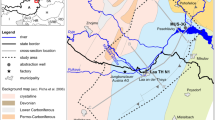Conclusions
-
1.
A simulated system including all three basic components of a fresh-water reservoir (water, soil, and plants) proved to be most effective in removing natural radioactive elements from the water.
-
2.
In the simulated systems investigated, the predominant buildup of uranium occurred in plant materials, that of thorium occurred in detritus and soil, and an equilibrium distribution of radium occurred in the components of a standing reservoir.
-
3.
With the introduction of natural radioactive elements into a standing reservoir, there is observed migration of uranium and radium in soluble form while migration of thorium, and probably of radium D also, is practically excluded.
-
4.
In simulated systems of a standing reservoir, the greatest specific activity and buildup capability is possessed by detritus; they are present to a lesser extent for plant materials and to an insignificant degree for soil.
-
5.
The phenomenon investigated may find commercial application for secondary purification of liquid radioactive wastes in artificially constructed storage ponds in which (as a supplement to the main process of physical deposition of the radioactive impurities) are cultivated certain types of aquatic plants.
Similar content being viewed by others

Literature Cited
V. G. Bakhurov, I. K. Lutsenko, and N. N. Shashkina, Radioactive Wastes from Uranium Plants [in Russian], Atomizdat, Moscow (1965).
V. I. Vernadskii, Dokl. Akad. Nauk SSSR, Ser. A, No. 20 (1929).
V. I. Vernadskii, Dokl. Akad. Nauk SSSR, Ser. A, No. 2 (1930).
B. N. Brunovskii, Tr. Biogeokhim. Labor., Akad. Nauk SSSR,2, 9 (1932).
B. N. Brunovskii and K. G. Kunashova, Tr. Biogeokhim. Labor. Akad. Nauk SSSR,3, 31 (1935).
J. Stoklasa, Biologie des Radium und Radioaktiven Elemente, Vol. 1, Biologie des Radium und Uranium, Berlin (1932).
E. Tsivoglou et al., Sewage and Industr. Wastes,30, 1012 (1958).
E. Tsivoglou et al., Survey of Interstate Pollution of the Animas River, Colorado-New Mexico, US Public Health Service, R. A. Taft San. Engng. Center, Cincinnati, Ohio (1959).
A. L. Agre and V. I. Korogodin, Med. Radiologiya,3, 67 (1960).
Manual of Radiation Hygiene [in Russian], Vol. 2, A. I. Mareya (editor), Medgiz, Moscow (1962).
E. A. Timofeeva-Ressovskaya, Tr. In-ta Biologii, Ural'skoge Filiala, Akad. Nauk SSSR, No. 30 (1963).
G. G. Polikartsov, Radioecology of Marine Organisms [in Russian], Atomizdat, Moscow (1964).
Additional information
Translated from Atomnaya Énergiya, Vol. 27, No. 2, pp. 134–137, August, 1969.
Rights and permissions
About this article
Cite this article
Iskra, A.A., Kulikov, N.V. & Bakhurov, V.G. Behavior of natural radioactive elements in standing reservoirs communication I. At Energy 27, 843–847 (1969). https://doi.org/10.1007/BF01180287
Received:
Revised:
Issue Date:
DOI: https://doi.org/10.1007/BF01180287



